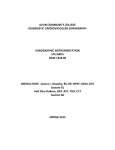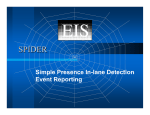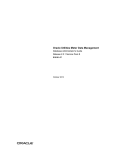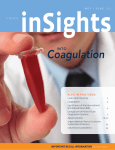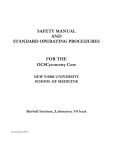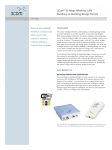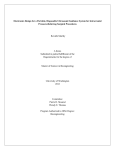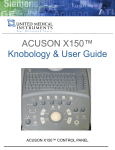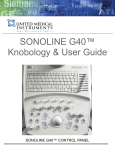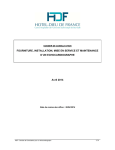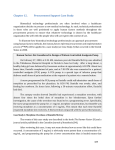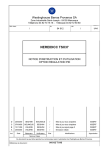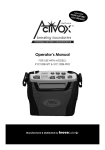Download ALVIN COMMUNITY COLLEGE
Transcript
ALVIN COMMUNITY COLLEGE DIAGNOSTIC CARDIOVASCULAR SONOGRAPHY SONOGRAPHIC INSTRUMENTATION SYLLABUS DASE 1318 Sections .01 and .60 INSTRUCTORS: Jessica L. Murphy, BS, RR -NPST, RDCS, RVT and Dina DuBose, AAS, CCT, RVS, RVT SPRING 2014 TENTATIVE CLASS/LAB SCHEDULE WEEK 1 DATE 01/16 TOPIC Review Syllabus Begin Unit 1 Waves Review Math Concepts READINGS Miele Ch. 1-2 LAB ACTIVITIES The 6 Ps Instrumentation Appendix A 2 01/23 US Physics - Basic Principles Miele Ch. 3-4 Attenuation and Pulsed Waves Knobology 3 01/30 Unit 1 (cont.) Handouts for Lab Knobology 4 02/06 Unit 1 (cont.) Finish chapters Experiments: Depth, Frequency, TGC, Compress, Power, Gain, PRF 5 02/13 Unit 1 Exam / Begin Unit 2 Sound Beam Anatomy Transducer Construction Miele Ch. 5 Review Midterm Lab Practical 6 02/20 Unit 2 Resolution Miele Ch. 4-6 Experiments: Frame Rate, 2D optimization, Dynamic Range, Smoothing, Post- Processing 7 02/27 Unit 2 – Transducer Modes and Frequency Experiments: XDCR type, Frequency, Harmonics, Fundamental 8 03/06 Unit 2 - System operation and Display Mid Term Lab Practical 03/13 SPRING BREAK – NO CLASSES! 9 03/20 Unit 2 Exam – Begin Unit 3 Doppler 10 03/27 Unit 3 Doppler 11 04/03 Unit 3 – Contrast Miele Ch. 10 Doppler and Color artifacts 12 04/10 Unit 3 - Hemodynamics Review Miele Ch. 12-13 Present Phantoms during lab 13 04/17 Unit 3 Exam – Begin Unit 4 Artifacts and QA Miele Ch. 8-9 Unit 4 – Artifacts Miele Ch. 8 14 04/24 15 05/01 16 Miele Ch. 7 Doppler and Color Controls Doppler and Color Optimization Doppler Optimization Final Lab Practical QA, Bioeffects, Safety Miele Ch. 11 - 19 QA Lab Prepare for SPI, Take it over the break! 05/08 Unit 4 Exam F/B Exam QA Lab completion Yes, both exams on same day unless we finish early enough to move it up. Let’s hope we can! This is a tentative schedule & is subject to change at the instructors’ discretion. Additional reading student for which student is responsible: all appendices, tables & charts in both books. Edelman and Kremkau are optional resources. COURSE INFORMATION DSAE 1318.01 Thursday 8:30-12:20 Jan 16 to May 08 DSAE 1318.60 Thursday 6:00-10pm Jan 16 to May 08 INSTRUCTOR INFORMATION Jessica Murphy BS, RRT-NPS, RDCS, RVT Office: S108D 281-756-5650 Assistant: 281-756-5625 Fax: 281-756-5606 Email: [email protected] Dina DuBose, BAT, CCT, RVT, RVS Office: S148 281-756-5663 Email: [email protected] Office hours by appointment and posted on office doors. Cell phone number will be posted in class for emergencies only. Office phone and email are the best way to contact your instructor. Course Description To provide an introduction to ultrasound principles and instrumentation including properties of ultrasound, interaction of ultrasound with tissue, transducers, Doppler, instrumentation, image display, artifacts, QA, bioeffects and ultrasound safety. Prerequisites Acceptance into DCVS Program or approval to audit from Program Director. Rationale The student should have a basic understanding of ultrasound systems and the physics concepts behind them to be able to obtain diagnostic images, correct artifacts, optimize images, and utilize instrumentation appropriately. This is an applied physics course. You will take the concepts you learn back to the equipment and apply it to the instrumentation. Required Textbook: Latest Editions of the following Miele, Frank. Ultrasound Physics and Instrumentation. Recommended Textbooks: Edelman, S. Understanding Ultrasound Physics, Fundamentals and Exam Review. 4th Ed. ISBN 0-9626444-4-7 Miele, F. Essentials of Ultrasound Physics The Board Review Book. 2008 ISBN 987654321 Kremkau, F. Sonography Principles and Instruments. ISBN 978-1-4377-0980-3 TEXTBOOK INFORMATION For information on the textbook and other course materials, including details about how to order your book online and have it delivered to you, visit the ACC College Store website. ADDITIONAL MATERIALS USB/ Jump Drive or CD R/W Scantron exam answer sheets Colored markers Paper clips, scotch tape, scissors, stapler and staples ACC DCVS polo or T-shirt to wear to lab ACC DCVS Name Tag to wear to lab Ream of printer paper, ink cartridges for lab printer Instructional Methods US physics consists of four (4) hours of instruction-per-week, over sixteen (16) weeks. This time is divided into lecture and lab components. The lectures will be supplemented with slides, overheads and video presentations when necessary. The lab portions will include demonstrations, exercises, and hands-on practice. At times, there will be equipment demos from various reps. Course Outline Unit 1 - Basic Ultrasound Physics Unit 2 - Transducers Unit 3 - Pulsed Doppler, Image and Display Unit 4 - QA, Bioeffects, Artifacts, Safety CLASSROOM PROTOCOL It is the right of each student to participate in his or her learning, and it is the responsibility of each student to not interfere with the learning of other students. Policies governing the classroom are provided in the ACC Student Handbook and students who repeatedly violate one or more of these policies will be subject to disciplinary action. ACADEMIC SUCCESS AND SUPPORT SERVICES ∗Americans with Disabilities Act ACC complies with ADA and 504 Federal guidelines by affording equal access to individuals who are seeking an education. Students who have a disability and would like classroom accommodations must register with the Office of Disability Services, A 136, (281)756-3533. Instructors are not able to provide accommodations until the proper process has been followed. ∗Behavioral Intervention Team (BIT) – Letting someone know The Behavioral Intervention Team (BIT) at Alvin Community College is committed to improving community safety. College faculty, staff, students and community members may communicate safety concerns to the BIT team by email, [email protected] or through an electronic reporting option located on the BIT page of the college website. ∗The ACC Library is an excellent source for research and writing help. For more information, visit the ACC Library Website or call 281-756-3559. ∗The ACC Learning/Tutoring Lab, located upstairs in building A, provides students with a variety of services including tutoring (math, writing, and other disciplines); computers and printers; a testing facility; and tables/carrels for studying. Call 281-756-3566 or visit the ACC Learning/Tutoring Lab Website for more information. ∗MyBlackboard -Any technical problems or issues with MyBlackboard should be directed to the Distance Education Department at [email protected] . Include your first and last name, student ID number and a description of the problem. Students will not be penalized if there is an interruption in MyBlackboard service and the instructor is notified of such an issue by the Distance Education Department. ∗WEBACCESS, Passwords or ACC Computer Lab Information- -Help Desk Website or contact the IT Dept. Help Desk at 281-756-3544. CODE OF ACADEMIC INTEGRITY AND HONESTY Alvin Community College students are members of an institution dedicated to the pursuit of knowledge through a formalized program of instruction and learning. At the heart of this endeavor, lie the core values of academic integrity which include honesty, truth, and freedom from lies and fraud. Because personal integrity is important in all aspects of life, students at Alvin Community College are expected to conduct themselves with honesty and integrity both in and out of the classroom. Incidents of academic dishonesty will not be tolerated and students guilty of such conduct are subject to severe disciplinary measures. TECHNICAL SUPPORT Computers are available for use by all registered ACC students in any of the 23 ACC/PCC computer labs, including the Cyber Lab, room A-173. Cyber Lab hours are: Mon-Thurs. 8:00am-8:00pm, Friday 8:00am5:00pm and Sunday 4:00pm-8:00pm. Call 281-756-3544 for more information about all ACC computer labs. METHOD OF EVALUATION Student evaluation is based on completion of unit examinations, homework assignments, attendance, and class/lab participation. The average is calculated by averaging unit exams and the hmwk/quiz average. Remember the lowest quiz/map grade will be dropped and the final exam may replace the lowest exam grade if the student has not missed more than one scheduled exam. Mind Maps Mind Maps may be given or assigned at any time during the course and will be announced in advance. We usually have a mind map due each class day except on major exam days. The lowest mind map grade will be dropped prior to calculating the homework average. If a student misses a map, it may NOT be made up. Weekly Mind Maps Mind maps will be done weekly over reading assignments and are due at the beginning of each class day (when not having a test – no mind maps are due on test day). Students will be assigned certain subjects for the mind maps during class. The mind map will be graded using the following criteria: Total possible -100 points 30 points – complete, all info included, each chapter done 20 points – used different colors, neatly created 20 points – used a visual graphic to convey information 15 points – creative and imaginative. 15 points – oral presentation Grade of Zero if absent You may email it to your instructor for a grade of 75 instead of zero if you know you will be absent. Grade of 75 if emailed to instructor Written: Required info - List the definition, formula, units, and typical values. Can it be changed? By what button?, What is it determined by? What is the significance for the sonographer or patient? Include “Ahhhaaa” moments and questions about what you don’t understand. Oral Presentation: Be prepared to discuss your mind map with the class. Explain your overall concept, tell us your ahhhaa moments, ask your questions, be prepared to answer faculty questions. If you are unsure of what or how to complete a mind map you may look up “Mind Mapping” on the internet. There are many valuable sites that explain the process. Quizzes Quizzes may be given at any time. They will be announced in advance. Quizzes cannot be made up if missed. The lowest quiz grade will be dropped before calculating the final average. Exams An exam will be given at the end of each unit. The exams will be averaged with the homework/quiz average to calculate the final grade. Any missed exams will be made up on the next class day or sooner by appointment!! THERE WILL BE NO EXCEPTIONS!! The final exam may be used to replace the lowest exam grade as long as the student has not missed more than one (1) exam. If a student misses a second (2nd) scheduled exam, the final will be used to replace that grade. Any missed exam after the second (2nd) one will result in a zero (0). – To deter students from missing their physics exams…5 points will be deducted from the exam grade if absent on test day without a written legitimate excuse with a valid note and a call to the instructor. STUDENTS MUST MAKE A 77 OR BETTER TO RECEIVE CREDIT FOR THIS COURSE! Grading System A = 91 - 100 B = 82 - 90 C = 77 - 81 F = Below 77 GRADES: Record Weekly Grades Here Mind Map 1 __________ Mind Map 2__________ Quizzes __________ Mind Map 3 Mind Map 4 - __________ __________ __________ Mind Map 5 Mind Map 6 - Record Major Grades below: Major Grades Assignment Average Unit 1 Exam Unit 2 Exam Unit 3 Exam __________ __________ __________ Grade Unit 4 Exam Final (to replace lowest test grade if**) LP1 _____ LP2 _____ Lab Practical Average Project – US Phantom Total Average The final course grade is calculated by averaging all of the major grades: homework/quiz average , phantom project, lab practical average, and each of the unit exams. Always notify your instructor if you are concerned with your grades or your status in the class. It is the student’s responsibility to keep up with their grades and course average. The instructor is available as needed for extra help or to discuss grades. Don’t wait until the end of the semester to address any problems. Keep track of your grades. Do not throw away any of your labs until the semester is over. If you notice a problem, contact your instructor. Do not let your grades get out of hand. Only one semester left after this one till graduation!!!! I.…..Incomplete No Incompletes or “I” grades will be given except for extreme circumstances. If an “I” grade is assigned and the course work is not completed by the pre-arranged time limit, this grade will convert to an “F”. W….Withdrawal It is recommended that the student talk to the instructor before withdrawing. Current course withdrawal information can be found in the online or printed version of the ACC Schedule for this semester. Students who file withdrawal requests by the published deadline and have not exceeded the withdrawal maximum will receive a grade of W. Course Competencies - Upon completion of this course, the student will be able to: 1. Demonstrate understanding of ultrasound physics, principles of instrumentation including ultrasound propagation properties, interaction of ultrasound with tissue, transducers, Doppler, image display, artifacts, bioeffects, QA, and safety. *(F1, F2, F3, F4, F5, C15, F12) 2. Apply knowledge to image acquisition, optimization, and artifact recognition. 3. 4. 5. *(F7, F8, C1, C9, C7, C16, C17) Select and use appropriate transducer on software application to tasks. *(F13, C5, C8, C18, C19) Optimize 2d, M-Mode, and Doppler appearance using appropriate controls. *(F9, F10, C8, C16, C20) Follow guideline and use ultrasound safely, and in an appropriate manner. *(F11, F12, F13, F16, C6)* Assignments – Other assignments and homework may be given periodically throughout the course. Due dates will be assigned at that time. These grades will be averaged together with mind maps and quizzes if any are given and used as a test grade in calculating the final grade. 5 points will be deducted from homework for each class date it is late. Attendance - Each student is expected to attend class regularly. It is the student's responsibility to make up any assignments that are missed. Please call or email the instructor if you are absent, to make arrangements for missed notes, assignments, handouts and/or tests. Also, it is a good idea to call a classmate to get a copy of the notes. You may bring a recorder to class and share recordings with each other in times of absence. 1. If a student misses more than four (4) classes, they may be dropped. 2. Students must attend class and lab regularly to receive credit. 3. Lab absences will count as one (1) absence - even if you are present for class. 4. Tardies greater than 20-minutes will count as an absence. Vitally important information is presented each day in class and lab. Physics is NOT one of those subjects you can miss and get it later. Please be in attendance at all times unless you are ill. Models - The Diagnostic Cardiovascular Sonography Program is in need of models/volunteers each class for the hands-on practice. If you, a family member, or friend would like to model, please let the instructor know so a volunteer schedule can be made in advance whenever possible, and to ensure an adequate number of models for each lab. Participants need to call 281/756-5625 for an appointment. When models are not available, students will scan each other. Bonus Points - Bonus points, up to two (2) per class, may be added to the final average. 1. Students can model for one (1) bonus point. 2. Students may attend local in services and society meetings for one (1) bonus point each. 3. Any additional bonus point activity as announced by the instructor. 4. Bonus points may also be used as a homework pass. Homework passes are only good for one assignment per course per semester. They are NOT allowed to be used to clinical assignments or any form of scanning assignment. Additional Information Badges You will need to get an ACC student badge. Take your paid tuition receipt to the Library. Parking You are required to have an ACC student parking permit. Go to the campus police department in H-Building. You will need: 1. Texas Drivers License 2. License Plate Number 3. Year, Make and Model of Vehicle Do not park in the white-striped parking spots and do not back into a parking spot. The white stripes designate Faculty/Employee parking. Violators’ vehicles may be towed! 2 LAB PRACTICALS: - One Major Grade Students will be tested on their knowledge of the equipment in the lab by 1. Finding the control 2. Demonstrating how it is used 3. State what it does and the initial setting The student will be tested twice (mid-term and final) with the instructor present and it will count as one exam grade. If the student fails the practical it will be repeated for a lower grade on each repeat. There will be an evaluation at mid-term and again at the end of the semester. If you pass on the first try you can make an A (91-100), on the second try you can make a B (85-90), and so on. Grading Rubric -1 slow in finding control but able to locate within 5 seconds. -1 could not state function of control or how to set it -5 could not find control Any grade below 85 must be repeated. See attached evaluation form. Course Requirements – 1. Attend class and lab and have no more than 4 absences 2. Turn in all assignments including weekly mind maps; take each unit exam and the final 3. Pass the mid-term and final lab practical 4. Make at least a 77 on the final average 5. Complete the project and participate as a member of a team DSAE 1318: Ultrasound Phantom Project Class Group Project: Homemade Ultrasound Phantom Form 2 groups with equal team members. Look up the recipe or create your own for making a homemade ultrasound phantom. Follow the recipe and place interesting objects into the phantom to be able to scan. Experiment with different recipes, containers, and objects to find something that works well. Use solid objects, hollow objects, and fluid filled objects, be creative. Once prepared, the members of the other student teams will have to scan the phantom locating each of the objects and try to guess what it inside. The designing team must make a map (answer key) to compare the results to. Phantoms will be on display for fellow students to scan and try to determine what types of objects are placed in each others phantoms. Which ever team gets the most correct objects will win a special prize. Each group will then give a short presentation about how the phantom was made, what role each student played, and the physics concepts learned in the process. You should use a poster board and or power point to illustrate the steps and concepts. This will be considered a major project grade. Specific Instructions: The purpose of this project is for students to gain a better understanding of ultrasound physics by completing research that will increase understanding of how an ultrasound phantom is created and the imaging physics or acoustic properties of different objects. Students will form groups. Each student in the group will have a designated responsibility. The students will present their phantom with the required information to the class. Some sort of poster or other visual aide should be included which details the required information. The project information/materials should include but not be limited to the following: The ultrasound scanning phantom with imbedded objects of differing acoustic properties. (research different recipes on the internet or do experiments to create your own) Be creative in what you prepare. Presentation, creativity and variety counts. A key to the item and location of objects in the phantom. (give the best estimate of the size, distance from edges, and depth of each object) Keep the key a secret until the other teams have the opportunity to scan your phantom and try to guess what’s inside. List of team member duties and specific roles or assignments. Visual aide explaining the physics of ultrasound at work in your specific phantom with terminology defined. Recipe used listing all ingredients including quantity. Direction that were followed on how the phantom was created and how it should be scanned. References listed The phantoms will be placed on display in the lab on the specified due date. Each team will take turns scanning the other team’s phantom. The team will print images from the phantom with the items “identified”. The mapped images will be compared to the key to determine if the unknowns were correctly identified and located. Once the maps and keys are compared, each team will have the opportunity to present the process and results orally to the group. The phantom projects will then be judged for creativity, attention to detail, and the accurateness of the information presented. Please let your creative juices flow and take pride in this project. Additional (non-ultrasound related) judges may come through to critique the projects and will count towards 25% of the overall grade. Assignment - ____DSAE 1318 Phantom Project____Team Name____________ Objective/Criteria Performance Indicators Needs Improvement Meets Expectations (<25 points) Information missing or not covered (25 points) Thoroughly and accurately covered roles, recipe, and concepts learned, physics properties of phantom including tissue characteristics of objects and artifacts created. Presentation (<25points) Presentation was confusing or AV media was not of highest quality (25 points) Clear and concise. The project /AV media neat and legible. Orally presented as a group. Creativity (<25 points) Project was not interesting. Visual aids did not contribute to the understanding of the material. (25points) The visual aids contributed to the understanding of the material. The project was “fun” to look at. The phantom held together and was interesting and easy to scan. Phantom (<25 points) Overall quality of the project, with 0 being the lowest score (25 points) The overall quality of the phantom: recipe, construction, objects, artifacts, key and scanned images. Bonus points No objects guessed in another phantom # Bonus points = the number of items correctly guessed in the other team’s phantoms. Information Research Total Points Out of 100 Team Members: _______________________________________________________________________ _______________________________________________________________________ POINTS Unit I Objectives - Students must gain a basic understanding of physical units, scientific notation, engineering notation, common units, and the metric system, as well as the basic properties of sound. Upon completion of this unit, the student will be able to: 1. define sound and ultrasound. 2. list and define acoustic variable. 3. list and define parameters used to describe sound. 4. identify the units, what determines it, values, if it can be changed by the operator. 5. list and define descriptors of pulsed and continuous ultrasound. 6. describe propagation of ultrasound through tissue. 7. discern between an ultrasound wave, pulse and continuous waves. Key Words - Know Definition as it Relates to Ultrasound including: definition, formula, units, typical value, what determines it, can it be changed, how is it changed, significance. Sound Ultrasound Compression Rarefaction Pressure Density Temperature Distance Transverse Wave Longitudinal Wave Period Frequency Amplitude Power Intensity Propagation Speed Wavelength Hertz Cycles Bulk Modulus Phase Difference Constructive Interference Destructive Interference Medium LARRD Resolution Pulse Pulse Repetition Period Pulse Repetition Frequency Spatial Pulse Length Pulse Duration Duty Factor Decibels Attenuation Absorption Reflection Scattering Rayleigh Scattering Half Value Layer Thickness Impedance Scatter Back Scatter Acute Angle Obtuse Angle Intensity Reflection Coefficient Intensity Transmission Coefficient Reflection Angle Incident Angle Snell's Law Refraction Range Equation Unit 1 Assignment – Mind Map topics as assigned due for a grade and to be presented in the class. Unit II Objectives Upon completion of this unit, the student will be able to: 1. 2. 3. 4. 5. 6. 7. 8. 9. define the components of a transducer and the piezoelectric effect. understand bandwidth and quality factor. know what determines frequency. illustrate the anatomy of a sound beam. define terms that describe sound beams and their properties. know how beams are focused. list and define display modes. list and define types of transducers. understand temporal resolution. Key Words - Know Definition as it Relates to Ultrasound including: definition, formula, units, typical value, what determines it, can it be changed, how is it changed, significance. PZT Matching Layer Damping Element Bandwidth Resonant Frequency Quality Factor Continuous Wave Pulsed Wave Sound Beam Focus Focal Length Focal Zone Near Field (Freznel) Far Field (Fraunhofer) Divergence Diffraction Huygen's Principle LATA Resolution Focusing A Mode C Mode B Mode M Mode B Scan Mechanical Scan Head Array Linear Annular Curvilinear Switched Phased Water Path Vector Array Duplex Real Time Temporal Resolution Line Density Sector LARRD Resolution Unit 2 Assignment –Mind Map topics as assigned due for a grade and to be presented in the class. Unit III Objectives Upon completion of this unit, the student will be able to: 1. define the components of a pulsed echo instrument. 2. list and define pulse modes. 3. understand receiver functions. 4. understand output power vs. receiver gain. 5. review display components. 6. understand concepts of image processing. 7. list types of storage media. 8. define the Doppler effect. 9. understand and correct aliasing. 10. list the differences between PW and CW. 11. define color Doppler and be able to distinguish color maps. 12. review Doppler displays. 13. determine the direction of flow given a color image. 14. adjust control settings to optimize images. Key Words - Know Definition as it Relates to Ultrasound including: definition, formula, units, typical value, what determines it, can it be changed, how is it changed, significance. Pulsar Bit Receiver Pre/Post Processing Display Read Magnification Storage Write Magnification Master Synchronizer Dynamic Range Continuous Wave Doppler Effect Pulsed Wave Velocity Amplification Uni-Directional Doppler Compensation Bi-Directional Doppler Compression Range Ambiguity Demodulation Range Specificity Rectification Aliasing Smoothing Niquist Limit Refection Cosine Angle Dynamic Range Color Flow Doppler Output Velocity Mode Gain Variance Mode CRT Turbulence Bistable Laminar Gray Scale Wall Filter Analog Packet Digital Spectral Analysis Scan Converter Fast Fourier Transform Pixel Autocorrelation Unit 3 Assignments 1. Unit 3 Assignment – REVIEW AIT questions at www.ardms.org a. Define the following terms: AIT, SIC, Hot Spot Question b. Write a paragraph explaining the purpose/intent of these new types of questions c. Give three examples of how the SIC will be used to test you. d. What kind of knowledge will you need to successfully answer these types of questions? Be specific and detailed. 2. Mind Map topics as assigned due for a grade and to be presented in the class. 13 Unit IV Objectives Upon completion of this unit, the student will be able to: 1. list the type of artifacts, what causes them and how to correct the problem. 2. know what Quality Assurance is and why it is performed. 3. understand how QA is accomplished, using test objects and phantoms. 4. know what causes Bioeffects, and how to limit the effects. 5. identify the performance characteristics which are measured during QA. 6. list the devices used for testing various aspects of the ultrasound system. 7. differentiate between types of bioeffects. 8. state the AIUM guidelines for intensity limits and prudent use of ultrasound. 9. list special circumstances when ultrasound should be with-held. 10. state the SDMS position on the following: student scanning, screening, non-medical use of US. Key Words - Know Definition as it Relates to Ultrasound including: definition, formula, units, typical value, what determines it, can it be changed, how is it changed, significance. Reverberations Range Accuracy Shadowing Calibration Enhancement Uniformity Mirror Image Hydrophone Foreground Radiation Force Side Lobes Acoustic Optics Grating Lobes Calorimeter Slice Thickness Thermocouple Multipath Crystals Beam Profiler Dosimetry A.I.U.M. Mechanistic Approach Dead Zone Empirical Approach Registration Accuracy Thermal Index Phantom Cavitation Normal, Transient, Stable, Inertial Sensitivity Mechanical Index Unit 4 Assignments: 1. Internet Assignment – Go to the AIUM and SDMS web sites and review current position statements regarding the use and safety of ultrasound. If there are any NEW standards compared to what is in your book, print them out. Due on the day of the Unit 4 Exam 2. Mind Map topics as assigned due for a grade and to be presented in the class. This last mind map is a “Free Mind Map” meaning you can do whatever you like: linear notes, power points, flash cards, or whatever your heart’s desire but it must still include color and visuals and be presented to the class. Due the week before the Unit 4 exam 3. Artifact – Find at least three artifacts in an image and print it out or insert it into a power point. Complete the following: Identify it, label it with an arrow , define it, state the physics of it, state if it is diagnostic or not, state if you would try to remove it or not and if so HOW? Due on the day of the Unit 4 exam 14 Ultrasound Physics Instrumentation Lab Practical Student Name: ____________________________________Instructor:____________________________ Date: ____________ Machine: _________________________________________Grade:___________ Grading System: S=Satisfactory, NI=Needs Improvement, U=unsatisfactory, N/A Start with 100% and deduct one point for each NI or U. Mid –term: Be able to locate the following by mid-term PWR ON/OFF, Pt ID: Application select: Transducer Freq: Compress: Smoothing: Post-Processing: Output power: Sector width: L-R, U-D invert: Printer controls: Annotate: Menu – analysis Msrmt calipers dist: Filters: Restart or Modify Change out probes Digital Acquisition Archive Review Sending to Ultralinq _____ _____ _____ _____ _____ _____ _____ _____ _____ _____ _____ _____ _____ _____ _____ _____ _____ _____ _____ Transducer select: Rev exam, delete clips Receiver gain TGC’s Pre-Processing: TV/Monitor controls: Depth: Image steering: Zoom/Res: Physio and controls: Msrmt calipers trace: Menu – set up: Freeze/Scroll: Power Down process: Cursor: Image/ref size Reports review Deleting Archive Reviewing Ultralinq _____ _____ _____ _____ _____ _____ _____ _____ _____ _____ _____ _____ _____ _____ _____ _____ _____ _____ _____ Final: Be able to locate the following by end of semester Color on, map, scale _____ Color ROI, size, location _____ Color packets, proc _____ Color/Doppler steering _____ Doppler baseline _____ PW, CW, update _____ Dopper gate, angle _____ Doppler volume _____ MMode on/off _____ Dual screen _____ Technical support # _____ Color gain, filter Color invert, baseline Doppler/Color Invert Doppler on, scale Doppler processing Harmonics on/off Pedoff probe Sweep speed MMode gain/proc Frame Rate display User’s Manual _____ _____ _____ _____ _____ _____ _____ _____ _____ _____ _____ 15 STUDENT INFORMATION SHEET NAME Home Phone # Work Phone # Cell # FAX # Email Address Print and write this very carefully Home Address (Street) (City) (Zip Code) Work Facility Work Address Your Background, i.e., Credentials Addition Information Yes, I would like my information on the roster. PLEASE RETURN COMPLETED FORM TO YOUR INSTRUCTOR! No, Please do not include my information on the roster.















